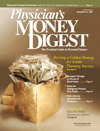Publication
Article
Physician's Money Digest
Investment Experts Agree to Disagree
Author(s):
When it comes to investment decisions andmarket analysis, having a bullish perspectiveat the wrong time could lead tofinancial disaster. Similarly, a bearapproach in what turns out to be a bull market couldleave investors out in the cold.
Stocks for the Long Run
Financial Analysts
Journal
Forbes
Dr. Jeremy Siegel, professor of finance at theWharton School of Business and author of the bestseller(McGraw-Hill; 2002), has traditionallyhad a bullish bent toward the market. On theother hand, Robert Arnott, chairman of First Quadrantinvestment firm and editor of the , is a bear through and through. The two squaredoff in a recent issue of , debating the near-andlong-term outlook for the stock market.
Stocks vs Bonds
The article points out that historically, stocks havereturned far more than bonds. Will that continue?
True to his character, Arnott is taking a bearishapproach. He says that over the next 25 years, stockswill probably beat bonds by no more than 1% a year.Siegel, of course, is more bullish. And while he doesn'tsee the gap between stock and bond returns being aslarge as in the past, he still believes the market will see a5% to 6% return on stocks over the next quarter century,adjusted for inflation. Real bond returns, he says, arelikely to be in the 0% to 1% range over the next 5 years,increasing to around 3% after that.
Arnott's perspective is based on the 1% to 1.5% historicalnorm for real growth in earnings and dividends.Siegel, however, says the future growth rate of dividendswill be at least 3%. "Dividend growth,"he explains inthe article, "will be higher because the payout ratio onearnings today is low."
On the likelihood that stocks will outperformbonds over the next decade, both experts hold true toform. Siegel considers this to be very likely, as high as90%. Arnott, on the other hand, says that based ontoday's levels, "there's a 60% chance that bonds willbeat stocks over the next 10 years."
Forbes
While Siegel tells that inflation is likely torun between 2.5% and 3%, Arnott is much more pessimistic.He cites several risk factors—including monetarypolicy, fiscal policy, and deficit spending allbeing aggressively expansionary—but seems mostconcerned about demographics. Arnott says that thepending retirement of baby boomers, who will wantto purchase goods and services that they no longerproduce, will put upward pressure on the prices ofgoods and services.
Long-vs Short-term Strategy
As might be expected, the two experts disagree whenit comes to recommending both long-and short-terminvesting strategies. For physician-investors with a 20-year horizon, Siegel leans heavily toward stocks, "with ahealthy dose of international."That healthy dose shouldbe as high as one third, according to Siegel, who likesdividend-paying stocks.
Arnott says that emerging markets are both interestingand attractive. However, he cautions investorsto have patience due to the high volatility of thesemarkets. He also says that Treasury inflation-protectedsecurities (TIPS) are interesting. "The thing thatwill preserve purchasing power through retirementwould be a laddered TIPS portfolio, one with staggeredmaturity dates,"Arnott says.
For the short term, the experts were asked whatthey thought stocks would do over the next 2 years.Arnott says the bond market will set the course: "Ifwe see a ratcheting up of interest rates, watch out. Ifwe see the fed having to cut interest rates, watch out.Stability in the bond market is the only scenario wherestocks do well in the coming year."
Siegel says that the political climate over the coming6-to 8-month period will affect the market. Themarket wants President Bush to win, Siegel forecasts,and if the polls go against him, that will have a negativeimpact.
